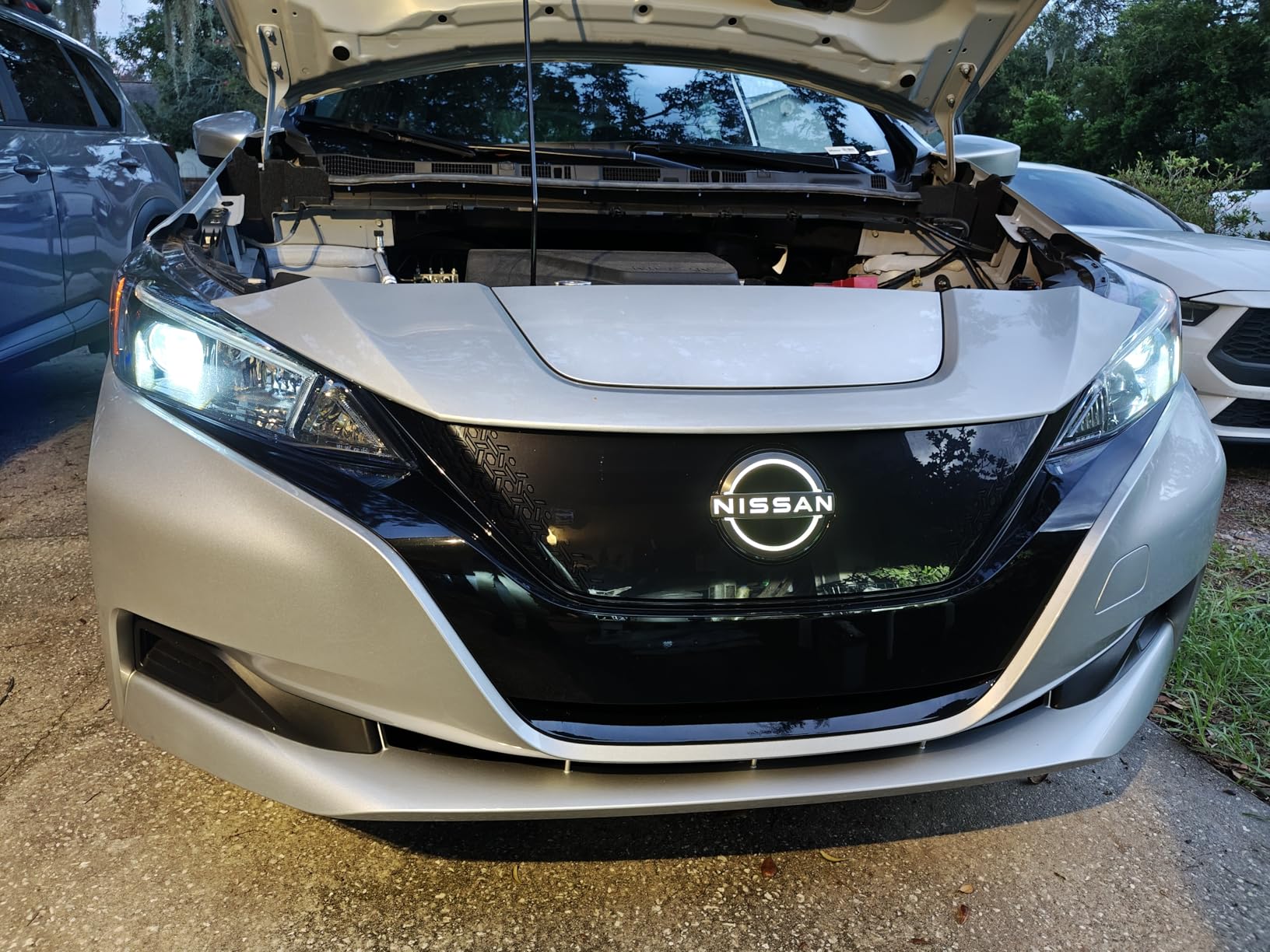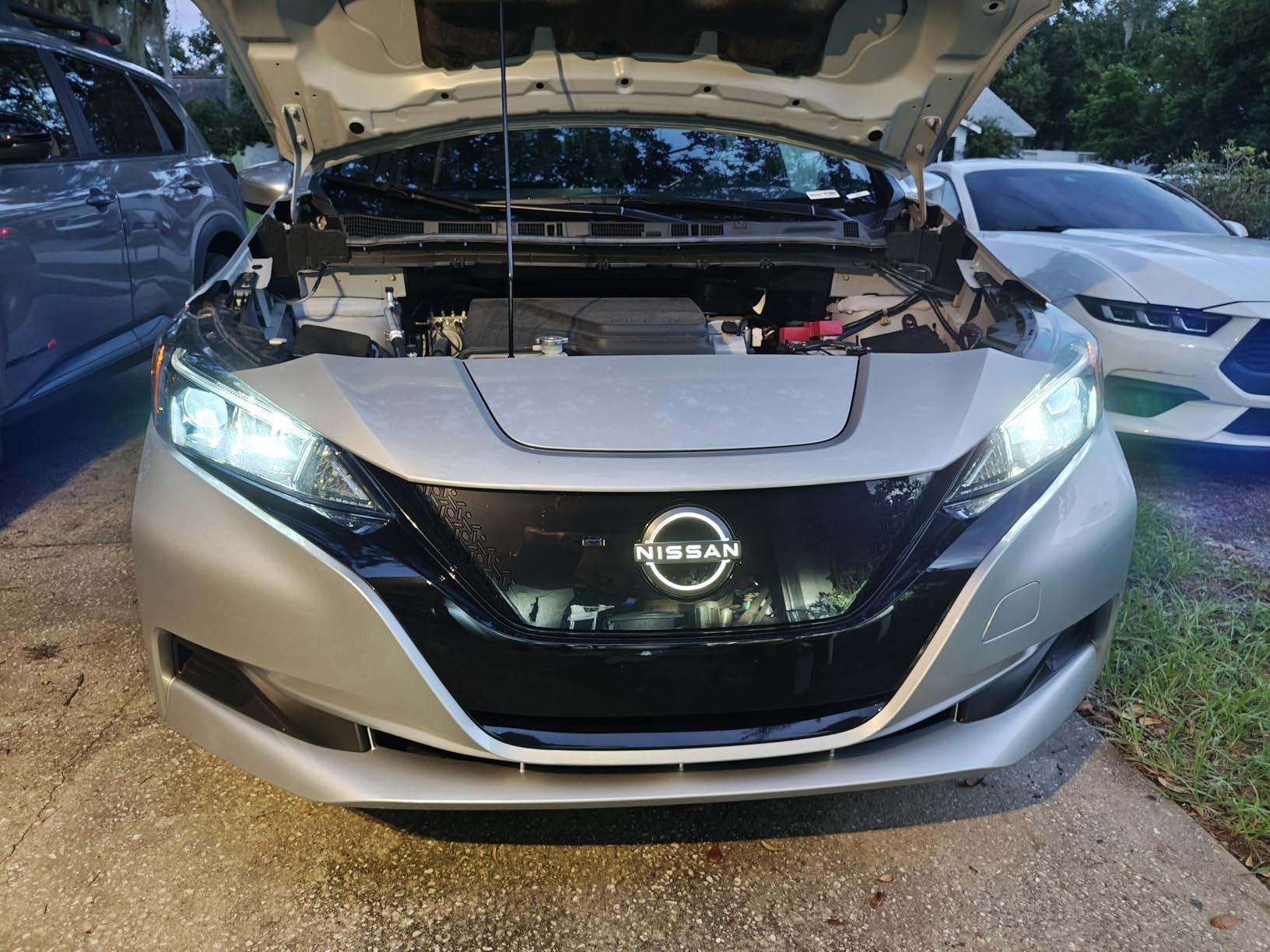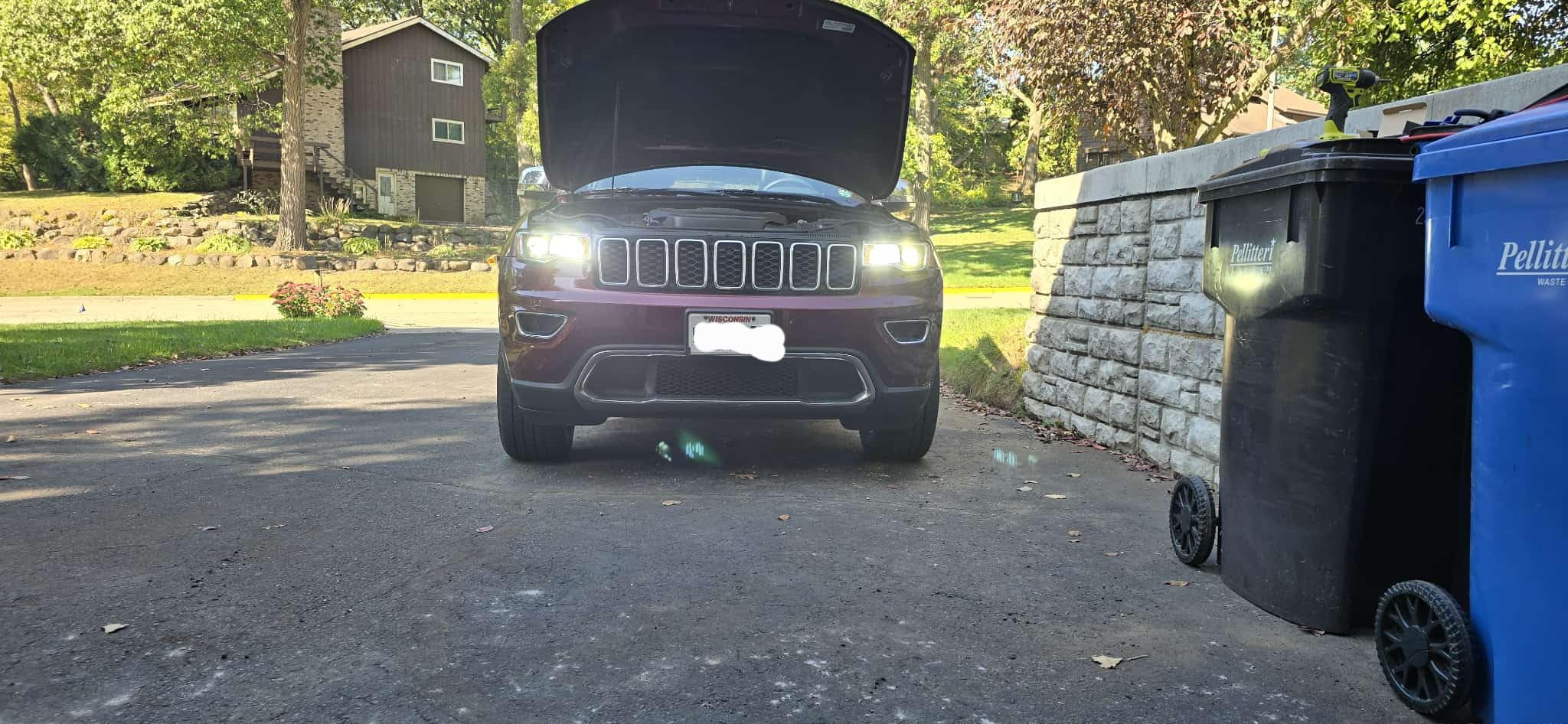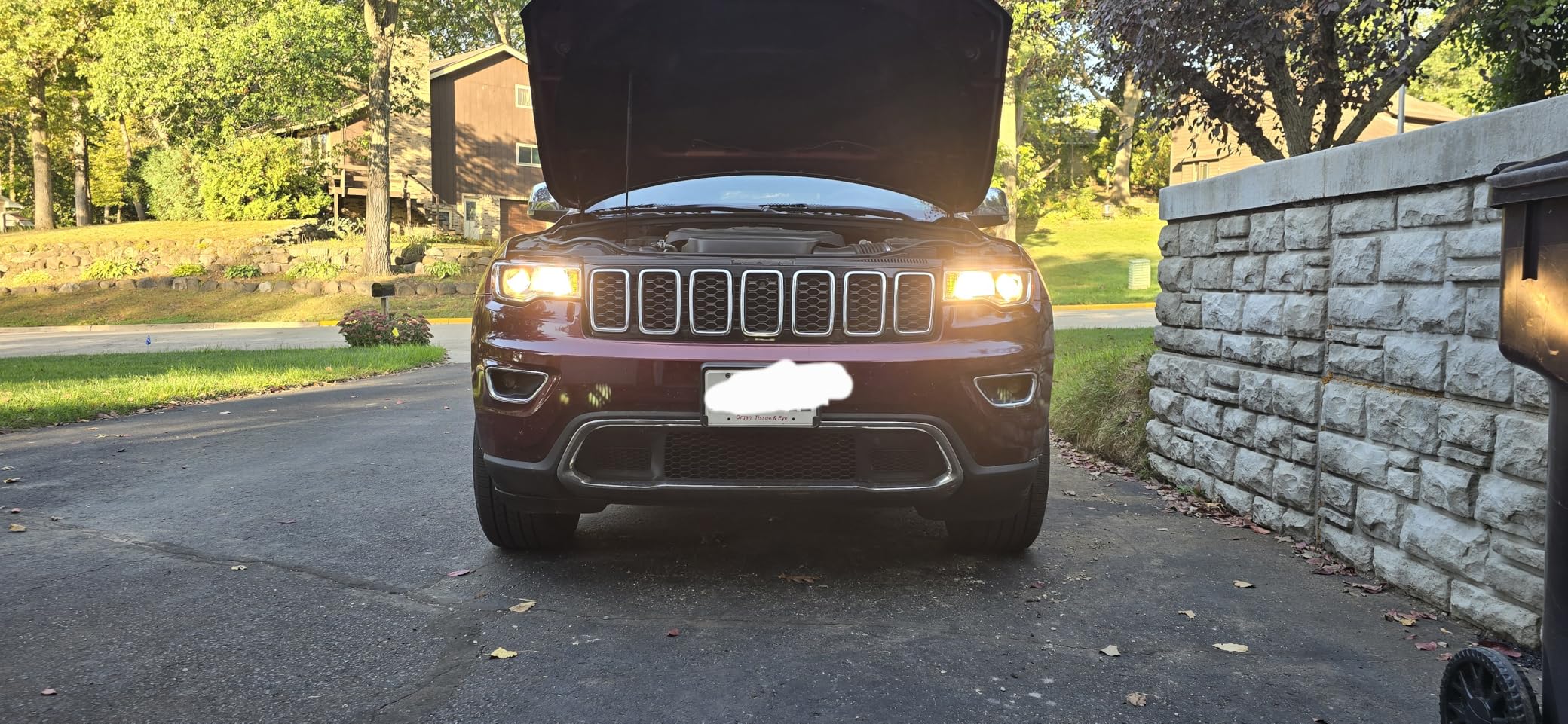Driving at night or in bad weather can be challenging, and having the right headlights makes all the difference for your safety and confidence on the road. If you're wondering whether to stick with traditional halogen bulbs or upgrade to newer LED technology, you're not alone. LED headlights offer brighter illumination and longer life but come with a higher price tag, while halogen lights are more affordable and easier to replace but don't last as long. If you're tired of constantly replacing burnt-out headlight bulbs or wondering why other drivers seem to have much better visibility than you do, here's your complete guide to headlight options - from budget-friendly halogen solutions to premium LED upgrades that could transform your nighttime driving experience.

What Are LED Headlights?
LED headlights use light-emitting diodes—small semiconductors that give off bright light instantly when electricity passes through them. These new lamps cast a white, sharp beam of light without the heat of traditional bulbs, which are much more energy-efficient. LEDs give off light very close to daylight, which improves night vision and color recognition. In newer vehicles, the diodes are typically part of the headlight assembly itself rather than replaceable bulbs. This fusion enables upscale features like adaptive beams that adjust based on driving conditions and create distinctive light patterns that characterize modern upscale vehicles.
What Are Halogen Headlights?
Halogen headlights are an older light technology found on the majority of cars for decades. Their functionality is actually quite simple: electricity is used to heat the filaments of tungsten within a compact bulb filled with halogen gas, which generates light. These bulbs have that classic warm-yellowish color that instantly characterizes a light source in a dark roadway. The filaments burn brighter and hotter than regular incandescent bulbs since the halogen gas prolongs its life. They're the traditional, easily replaced bulbs that screw into your vehicle's headlight assembly and have been standard equipment on most vehicles until recent years.
Halogen vs LED Headlights: Feature Comparison

| Feature | Halogen Headlights | LED Headlights |
| Brightness | Warm yellow light (3000K), approximately 1,100 lumens | Bright white/blue light (4000K-6000K), 1,600+ lumens, up to 3x brighter than halogens |
| Light Distance | Typically reaches around 100 meters (328 feet) | Can illuminate up to 300 meters (985 feet) |
| Visibility | Adequate for normal conditions but less effective in poor weather | Enhanced visibility in poorly lit areas and adverse weather; illuminates larger area giving more reaction time |
| Energy Efficiency | Higher energy consumption (~55 watts), only about 10% efficient | Energy-saving (~15-20 watts), about 80-90% efficient, reducing vehicle electrical load |
| Lifespan | 500-1,000 hours, typically needs annual replacement | 20,000-50,000 hours, can last the lifetime of the vehicle |
| Cost | Affordable ($10-$50 per pair) | Higher initial investment ($40-$120+ per pair) |
| Heat Emission | Produces significant heat, most energy wasted as heat | Generates minimal heat, improving efficiency and longevity |
| Installation | Easy to replace, simple twist-lock design | Some are plug-and-play while others may require professional installation |
| Light-up Time | Slight delay in reaching full brightness | Instant illumination upon activation |
| Aesthetics | Traditional yellowish appearance | Modern, crisp appearance with distinctive light patterns |
| Environmental Impact | Contains tungsten and other materials | No hazardous materials like mercury, easier to recycle |
Pros and Cons of LED Headlights
If you're wondering whether upgrading to LED headlights is worth the investment, here's what you need to know about their strengths and limitations before making your decision.
Pros:
- Better Brightness: LEDs produce significantly more light (1,600+ lumens) than halogen bulbs, providing you with whiter, brighter light that's nearer to daylight.
- Energy Efficiency: LEDs consume about 80% less power than halogen bulbs (15-20 watts vs. 55 watts), which reduces the electrical load on your car's system and can result in improved fuel efficiency.
- Longer Lifespan: With an operational life of 20,000-50,000 hours compared to halogen's 500-1,000 hours, LEDs can potentially outlive your car's life.
- Instant Lighting: As opposed to halogens, which gradually heat up to full brightness, LEDs hit full output the instant they are turned on.
- Enhanced Safety: The broader, longer light throw (up to 300 meters, as opposed to 100 meters for halogens) provides more reaction time and better visibility under poor conditions.
- Fresh Aesthetics: LEDs' distinctive, sharp light pattern gives vehicles a modern, high-end appearance.
Cons:
- Higher Upfront Cost: Good quality LED headlights can range from $40-$120+ per pair, whereas halogens are available for $10-$50, making it a substantial initial investment.
- Heat Management Needed: Though LEDs emit less heat in the front, they do emit heat at the base, which needs to be managed using good quality heat sinks or cooling systems to avoid damaging the internal components.
- Complex Replacement: The majority of LED systems are integrated into the headlight assembly and hence are more complicated and expensive to replace compared to replacing a halogen bulb.
- Performance in Fog: The intense brightness of LEDs sometimes produces more glare in foggy or snowy conditions due to light reflection off moisture particles.
- Compatibility Issues: In certain vehicles, an upgrade from halogen to LED may need additional adapters or modifications, which may add complexity to the installation.
Pros and Cons of Halogen Headlights
Halogen headlights have been the industry standard for decades, and understanding their strengths and limitations can help you determine if they remain the right choice for your vehicle needs.
Pros:
- Affordability: Halogen bulbs are far less expensive than modern alternatives, typically costing as little as $10-$50 a set, so they're affordable to replace.
- Universal Availability: Halogen bulbs are widely available at almost all who retail auto accessories, from gas stations to auto parts stores to online retailers, so you'll never be more than a few miles away from a replacement.
- Easy Installation: The majority of halogen bulbs feature a simple twist-lock mechanism that offers tool-free replacement within minutes, which is easy even for drivers with minimal mechanical skills.
- Better Performance in Fog: The lower intensity and warmer color temperature of halogen light create less glare when reflected off water droplets, which provides better visibility in fog or mist.
- Well-established Technology: Halogen technology is so familiar that almost every mechanic and even some car owners can diagnose and fix lighting issues without training.
Cons:
- Limited Illumination: With only about 1,100 lumens and a yellowish color (about 3000K color temperature), halogens are far less capable of lighting the road than more modern choices.
- Frequent Replacement: With a typical lifespan of just 500-1,000 hours, halogen bulbs often require replacement every 1-2 years, depending on how much you drive at night.
- Energy Inefficiency: Halogen bulbs consume approximately 55 watts of power while converting only 10% of that energy to light—the rest is wasted as heat, placing greater demand on your vehicle's electrical system.
- Shorter Projection Distance: The light typically only travels about 100 meters (328 feet) ahead, providing less reaction time than with more modern lighting technology.
- Old Appearance: The yellowish hue of halogen lights can make cars look old compared to the clean, white light of newer lighting technology.
Which Headlight Is Better for Different Driving Conditions?
Selecting the right headlight technology depends largely on where and how you drive. Different environments and driving scenarios create unique visibility challenges that certain headlight types address better than others.
1. City Driving
- Best Choice: Premium halogen or mid-range LED headlights
- Why: City environments have abundant ambient light and lower speed limits, reducing the need for maximum illumination. Here, you want balanced light that won't create excessive glare for other drivers.
- What to Look For: Look for models with precise cutoff patterns that minimize upward light scatter. Note the fact that several municipalities have provisions for headlamp brightness and color temperature in towns, so your LEDs must be properly directed lest they blind oncoming traffic at an approaching stop sign and during crowded traffic conditions.
2. Highway Driving
- Best Choice: High-quality LED headlights
- Why: Highway driving demands longer visibility distances, making LEDs ideal with their ability to project light up to 300 meters ahead versus halogen's 100 meters.
- Good to Know: Use LEDs with a minimum 4000K-5000K color temperature and 8000+ lumens output for best highway performance. These systems' instant-on ability delivers full brightness immediately upon exiting tunnels or shadowed overpasses, while halogens take time to build to full output—a real safety benefit at highway speeds.
3. Off-Road Driving
- Best Choice: High-output LED systems with supplemental lighting
- Why: Off-road environments require both distance illumination and peripheral lighting to spot obstacles and terrain changes.
- Worth Noting: For serious off-road use, installing LED light bars or supplementary spotlights at multiple heights to supplement your headlights is a good practice to gain better depth perception in challenging terrain—especially helpful for nighttime travel through obstacles.
4. Rural/Country Roads
- Best Choice: LED headlights with adaptive features
- Why: Dark country roads with potential wildlife hazards benefit from LEDs' longer throw distance and broader coverage area.
- Pro Tip: Invest in systems with adaptive front lighting that can adjust beam patterns according to steering input, providing enhanced illumination around the rural road bends. Be aware that the brutal contrast between LED brightness and surrounding blackness can cause fatigue on long rural journeys; many high-end LED systems now incorporate anti-fatigue technology specifically designed to reduce this effect, so they're worth paying extra for regular rural users.
5. Poor Weather Conditions
- Best Choice for Fog: Selective yellow halogen or yellow-tinted LED fog lights (2700K-3000K)
- Best Choice for Rain/Snow: LEDs with precise beam cutoff
- Why: Lower color temperatures produce less backscatter in moisture-laden air. In fog specifically, halogen's warmer output creates less reflective glare off water particles.
- What to Look For: For dedicated fog lights, consider JDM Yellow bulbs or applying Lamin-X yellow film over LEDs to improve visibility in heavy mist conditions. Many modern vehicles allow selective activation of fog lights independent from headlights, letting you optimize visibility as conditions change—a feature worth considering if you frequently drive in areas prone to rapid weather shifts or morning fog.
6. Night Driving on Unlit Roads
- Best Choice: High-performance LED headlights
- Why: Maximum illumination distance and width becomes critical when ambient light is absent, making LED's superior output essential.
- Good to Know: Select LED systems with high luminous intensity and color temperatures around 5000K-6000K for optimal night visibility without causing eye fatigue. LEDs' color rendering index (CRI) better approximates daylight, improving contrast recognition of roadside hazards and reducing night driving fatigue over long periods—particularly valuable for rural commuters or those who frequently travel between cities after dark.
When making your final decision, consider the primary environments where you drive most frequently and choose a lighting solution optimized for those conditions. Many drivers with varied driving needs find that LED technology offers the best overall performance across different scenarios, despite the higher initial investment.
How Do LED and Halogen Headlights Compare in Environmental Impact?
Headlight technology affects more than just your visibility—it impacts your car's environmental footprint too. LED and halogen headlights differ significantly in their environmental effects throughout their lifecycle. Here's what eco-conscious drivers should know when choosing between these options.
Environmental Impact Comparison: LED vs. Halogen
| Factor | Halogen Headlights | LED Headlights |
| Energy Efficiency | Converts only 10% of energy into light, wasting 90% as heat | Converts up to 90% of energy into light with minimal heat waste |
| Power Consumption | Typically 55-65 watts per bulb | Typically 15-25 watts per bulb |
| Lifespan | 500-1,000 hours (1-2 years) | 15,000-50,000 hours (15+ years) |
| Waste Generation | Frequent replacement needed | Rarely needs replacement |
| Hazardous Materials | No mercury, uses halogen gases | No mercury or toxic gases |
| Recyclability | Limited recyclability | Better recyclability, though circuit boards are challenging |
| Manufacturing Impact | Simpler production, lower initial resources | More complex manufacturing, higher initial resources |
| Vehicle Efficiency | Increases fuel consumption by 0.1-0.2 mpg | Improves fuel economy by up to 0.2 mpg |
| Carbon Footprint | Higher lifetime emissions | Lower lifetime emissions overall |
LEDs win the environmental contest despite their more resource-intensive manufacturing. Their dramatically better energy efficiency and much longer lifespan mean significantly lower environmental impact over time. One set of LED headlights can replace up to 30 halogen bulbs during your car's lifetime, reducing waste and saving fuel. For most drivers looking to make their vehicle greener without sacrificing safety, LED headlights are one of the simplest and most effective upgrades available.
What Should You Check Before Buying New Headlights?
Before rushing to upgrade your headlights, taking time to consider several key factors can save you money, frustration, and potentially legal issues down the road. The right headlight for your vehicle depends on more than just brightness—compatibility, light characteristics, longevity, and regulations all play important roles in making a smart choice.
1. Will These Headlights Fit My Car?
- What to Check: Ensure the headlights physically fit your exact car model, make, and year. Check the bulb type code on your current headlight (such as H11, 9005, or H7) or refer to your owner's manual.
- Why It Matters: The greatest headlights will be useless if they don't fit into your housing. Most online retailers offer vehicle-specific lookup functions that can double-check compatibility before buying.
2. How Bright Are These Headlights?
- Good to Know: Brightness is measured in terms of lumens—larger numbers equal brighter light. Most halogen bulbs produce 700-1,500 lumens, while LEDs produce 2,000-10,000 lumens.
- Quick Tip: Not everything that shines brightly is best. Extremely bright headlights can blind oncoming traffic and can even be banned. For everyday driving, 2,000-4,000 lumens provide great visibility without excessive glare.
3. What Color Will My Headlights Be?
- What Works Best: Color temperature (in Kelvin) determines whether light is yellowish (3000K), neutral white (4300K-5000K), or bluish (6000K+).
- Practical Choice: Most drivers like 4300K-5000K as the best compromise between visibility, low eye strain, and natural color rendering—such as natural daylight.
4. How Long Will These Headlights Last?
- Worth Noting: Halogen bulbs have a lifespan of 500-1,000 hours of use (about 1-2 years of normal driving). LEDs have a lifespan of 15,000-50,000 hours—sometimes longer than the vehicle itself.
- Cost Consideration: While LEDs are more costly upfront ($40-150 for a pair vs. $10-30 for halogens), their extended lifespan means fewer replacements and perhaps less long-term cost.
5. Are These Headlights Legal to Use?
- Important Warning: Headlight modifications must comply with Department of Transportation (DOT) regulations. Look for "DOT approved" markings on the packaging.
- Buyer's Tip: Some LED "upgrades" designed for halogen housings create improper beam patterns that can blind other drivers and fail safety inspections. Choose bulbs specifically designed to work with your existing housing type without causing excessive glare.
6. How Hard Are These Headlights to Install?
- Shop Smart: Halogen replacements are typically simple DIY jobs. LED upgrades might require additional wiring, heat sinks, or voltage regulators depending on your vehicle.
- Before You Buy: Check if installation requires special tools or professional help, which adds to the total upgrade cost. Many modern LED options offer plug-and-play installation with no modification needed.
When making your final decision, balance these factors based on your specific needs and budget. Remember that the best headlight is one that offers improved visibility while respecting other drivers on the road. If you are uncertain about installation or legal compliance, consulting with an automotive lighting specialist can help ensure you make the right choice for both safety and satisfaction.
Make the Smart Headlight Switch Today
LEDs win on brightness, energy efficiency, and lifespan—they'll likely outlast your car while giving you better nighttime visibility. Yes, they cost more upfront, but you'll save by never replacing them. Just make sure they're legal for your car's housing system. Halogens still make sense if you're on a tight budget or rarely drive after dark. Before you buy, check what fits your car model, what's legal in your area, and how long you plan to keep your vehicle. The right choice gives you safer, more comfortable night driving without breaking the bank.
LED vs. Halogen Headlights: Your Most Common Questions Answered
Q1: How bright is a 20W halogen?
A 20W halogen bulb will typically produce about 300-400 lumens. That's very dim for headlights, as standard automotive halogen headlight bulbs are closer to 55-65W and produce 700-1,500 lumens.
Q2: Are halogen or LED headlights better?
LED headlights outperform halogens in all respects. They're 4-5 times more efficient, last 15-30 times longer (often longer than your vehicle), are more visible, and operate cooler. Halogens only win on initial cost—they're typically $10-30 per pair versus $40-150 for LEDs.
Q3: Is it illegal to replace halogen headlight bulbs with LEDs?
In most places, yes—except if you are installing LED bulbs that have specifically been certified for your halogen housings. Standard LED retrofits will create inappropriate beam patterns that blind other drivers. Look for bulbs that are DOT/SAE certified for legal use in halogen housings, and always check your local laws prior to upgrading.
Q4: What is the LED equivalent of a 20-watt halogen bulb?
A 4-5W LED is as bright as a 20W halogen. LEDs convert electricity to light about 4-6 times more efficiently, so you need so much less power to get the same brightness.
Q5: A 50-watt equivalent for halogen LED is what?
A 50W LED would have the same illuminating power as a 250-300W halogen headlight—hugely, hugely bright to use in your car. Almost all LED headlights actually only need 15-25W of power and create more brightness than 55W halogens.
Q6: What is the equivalent of 25W halogen in LED?
A 25W halogen bulb (around 400-500 lumens) equates to roughly a 5-7W LED bulb when it comes to light.
Q7: Are there halogen headlights as bright as LED?
No, even performance halogens can't keep up with mid-range LEDs because of the technological physical limitations. The most powerful halogens reach only around 1,700 lumens, whereas standard LED headlights emit 2,000-4,000 lumens. Halogens would need unreasonable amounts of power to achieve LED-level intensity and would generate deadly levels of heat.




